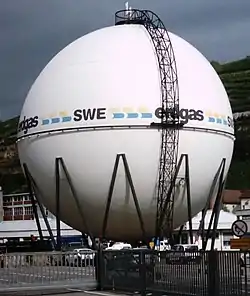San Juanico disaster
The San Juanico disaster was an industrial disaster caused by a massive series of explosions at a liquid petroleum gas (LPG) tank farm in San Juanico, Mexico (outside of Mexico City, Mexico) on 19 November 1984.[1] The explosions consumed 11,000 m3 of LPG, representing one third of Mexico City's entire liquid petroleum gas supply. The explosions destroyed the facility and devastated the local town of San Juan Ixhuatepec, with 500–600 people killed, and 5000–7000 others suffering severe burns.[2] The San Juanico disaster was one of the deadliest industrial disasters in world history.

Facility
The incident took place at a storage and distribution facility (a "terminal") for liquified petroleum gas (LPG) belonging to the multi-state enterprise, Petroleos Mexicanos (PEMEX). The facility consisted of 54 LPG storage tanks; 6 large spherical tanks (four holding 1,600 cubic metres (57,000 cu ft) and two holding 2,400 cubic metres (85,000 cu ft)) and 48 smaller horizontal bullet shaped tanks of various sizes. All together the tanks contained 11,000 cubic metres (390,000 cu ft) of a propane/butane mixture at the time of the accident.
Origin
The disaster was initiated by a gas leak on the site, likely caused by a pipe rupture during transfer operations, which caused a plume of LPG to concentrate at ground level for 10 minutes. The plume eventually grew large enough to drift on the wind towards the west end of the site, where the facility's waste-gas flare pit was located.
The fire
At 5:40 a.m., the cloud reached the flare and ignited, resulting in a vapor cloud explosion that severely damaged the tank farm and resulted in a massive conflagration fed by the LPG leaking from newly damaged tanks. Just four minutes later, at 5:44 a.m., the first tank underwent a BLEVE (Boiling Liquid/Expanding Vapor Explosion). Over the next hour, 12 separate BLEVE explosions were recorded. The fire and smaller explosions continued until 10 a.m. the next morning. It is believed that the escalation was caused by an ineffective gas detection system.
Damage and casualties
The town of San Juan Ixhuatepec surrounded the facility and consisted of 40,000 residents, with an additional 61,000 more living in the hills. The explosions demolished houses and propelled twisted metal fragments (some measuring 30 tons) over distances ranging from a few meters to up to 1,200 metres (3,900 ft). The explosion shock wave destroyed a range of 5 km-7Km of houses and businesses at various level. Windows were found destroyed at 10 km due to the blast wave. Much of the town was destroyed by the explosions and ensuing fire, with the current statistics indicating 500 to 600 deaths, and 5,000–7,000 severe injuries.[3] Radiant heat generated by the inferno incinerated most corpses to ashes, with only 2% of the recovered remains left in recognizable condition.
References
- Arturson, G. (April 1987). "The tragedy of San Juanico--the most severe LPG disaster in history". Burns Incl Therm Inj. 13 (2): 87–102. doi:10.1016/0305-4179(87)90096-9. PMID 3580941.
- "Accidente de San Juan de Ixhuatepec (México D.F., México)". www.unizar.es. Retrieved 11 June 2008.
- Arturson, G. (April 1987). "The tragedy of San Juanico--the most severe LPG disaster in history". Burns, Including Thermal Injury. 13 (2): 87–102. doi:10.1016/0305-4179(87)90096-9. PMID 3580941.
- Universidad de Zaragoza - Reporte de Accidente de San Juan Ixhuatepec
- Protección Civil Anda Lucia - Datos sobre la explosión de San Juanico
- Arturson, G (April 1987). "The tragedy of San Juanico--the most severe LPG disaster in history". Burns Incl Therm Inj. 13: 87–102. doi:10.1016/0305-4179(87)90096-9. PMID 3580941.
External links
- Explosiones en San Juanico - YouTube video on the disaster showing casualty response, burning LPG spherical tanks, among other things
- PEMEX LPG Terminal, Mexico City, Mexico. 19 November 1984 - Health and Safety Executive